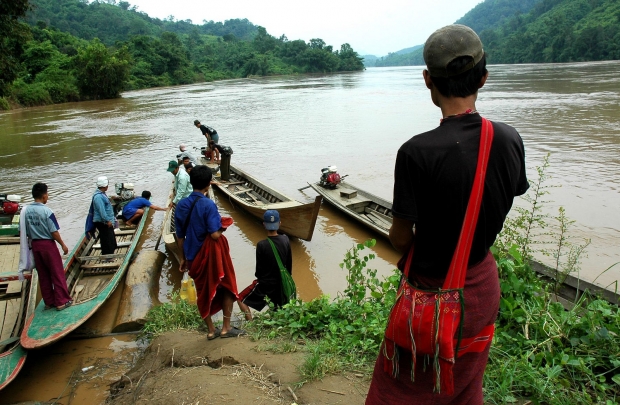Can Myanmar’s Hydropower Study Truly Be for the People? | Myanmar Times
This article originally appeared in the Myanmar Times.
In recent weeks, violent clashes in Kayin State have further disrupted Myanmar’s fragile peace process. Fighting between the Democratic Karen Buddhist Army (DKBA) and the government-sponsored Border Guard Force (BGF) in Mae Tha Waw areas of Hlaingbwe township, and more recently near Kawkareik township, has displaced over a thousand people. Entire families have fled their homes and are left stranded with limited access to food and assistance, producing nothing short of a humanitarian crisis. Across the border in Thailand, nearly 60,000 people remain in refugee camps, having fled ongoing conflict over the past two decades.
The deadly conflict is taking place around the construction site of the Hat Gyi hydropower dam on the Salween River. The 1360-megawatt project is slated for development by a consortium of Thai, Chinese and Myanmar companies, with the electricity generated to be exported to Thailand. Fighting has escalated as plans to build the project move forward, with both groups struggling to wrest control of the area.
Against this backdrop, in September the International Finance Corporation (IFC), the private sector lending arm of the World Bank Group, together with the Ministry of Electric Power (MOEP) and the Ministry of Environmental Conservation and Forestry (MOECAF), launched a Strategic Environmental Assessment (SEA) for Myanmar’s hydropower sector in Nay Pyi Taw. The SEA falls within a broader program of water reform in the country, supported by the World Bank. Last week marked the first meeting of the multi-stakeholder Advisory Group the IFC has convened to guide the SEA process.
The stated aim of the SEA is to achieve “broad consensus” on the equitable and sustainable development of hydropower dams across the country. The IFC has proposed a process of public engagement and negotiation, claiming this will avoid major environmental and social impacts and achieve widespread agreement on necessary trade-offs and ways to share benefits with those displaced or adversely affected by dams.
The SEA is an important step. Given the high social and environmental costs associated with the hydropower sector, it is an opportunity to build critical knowledge for accountable and informed decision-making. If done well, the SEA could enable the Myanmar government and people to comprehensively examine the full range of options available for providing energy while protecting its rivers and community rights; and with this together set the agenda for an inclusive and sustainable energy future. This can only be achieved through a transparent and participatory process, with the meaningful involvement of the most vulnerable groups. Such people include displaced persons and refugees, whose homes are poised to be lost to reservoirs and hydro stations, while their perspectives are often invisible in decision-making.
Whether the SEA can achieve this remains an open question.
In addition to Hat Gyi, other proposed dams are in active conflict zones and areas populated by Myanmar’s diverse ethic peoples. The 7100MW Mong Ton dam on the Salween River in Shan State will flood a war-torn area long subject to mass displacement. The IFC’s Performance Standards require participatory and transparent consultations, the “free, prior and informed consent” of indigenous peoples and sensitivity to the risks of operating in conflict and post-conflict zones. Little information is available as to how these standards will be effectively implemented in situations such as the current crisis in Kayin State or the refugee population in Thailand, who are yet to return home.
IFC standards also mandate the assessment of the cumulative impacts of hydropower development. The Salween is a transboundary river, originating in China and with stretches forming the border between Thailand and Myanmar. The Hat Gyi and Mong Ton dams, and other projects in a planned cascade on the Salween, would have transboundary impacts in Thailand, yet these appear to fall outside of the scope of the SEA, which will only involve assessment and consultations in Myanmar.
The hope is that the assessment will inform future government decisions on individual projects. With controversial planned dams such as Hat Gyi and Mong Ton already quietly progressing, it is unclear whether the SEA will be able to stop the clock to enable meaningful and inclusive debate about whether such projects should be built. In the case of the Mekong River, a comprehensive SEA on mainstream dams commissioned by the Mekong River Commission in 2010 recommended a 10-year moratorium on dam building to enable further studies, yet the advice was disregarded in the rush to harness the river’s hydropower potential. The flurry of dam-building has come at the expense of the river’s rich resources and the interests of riverine communities.
Around 34 million people in Myanmar lack access to electricity, a deficit the IFC often cites in discussing the SEA. But many of the large-scale projects that will be examined in the assessment would generate capacity for export, not domestic consumption. Because 70 percent of Myanmar’s population live in off-grid rural regions, prioritising small-scale and decentralised energy sources over mega-dams is a better way to meet the immediate needs of local people. The SEA appears to start from the assumption that large-scale hydropower is a given, rather than enabling consideration of alternatives that could inform open discussion on the best means of meeting Myanmar’s energy demands and priorities.
Myanmar has an opportunity to balance equitable and sustainable development of the energy sector while preserving rich ecosystems and ecologically sensitive areas. Getting this right is complex. The SEA Advisory Group must carefully consider how to ensure sensitivity to the country’s complex history and a process that is truly inclusive of the needs and perspectives of all its people.
Pianporn (Pai) Deetes works as the Thailand and Burma Campaigns Director for International Rivers, an international NGO working to protect rivers and the rights of communities who depend upon them.



